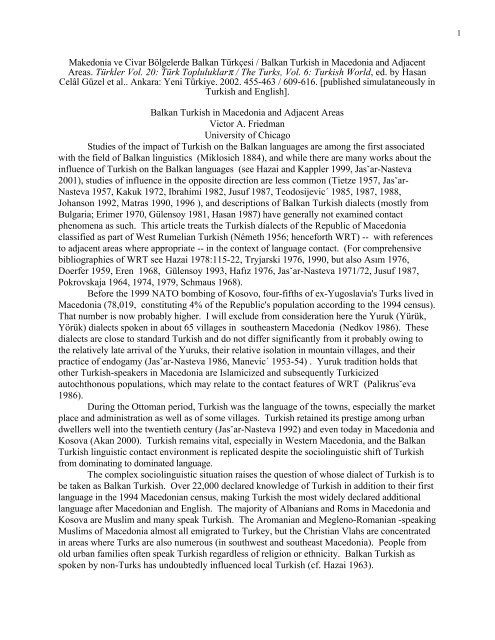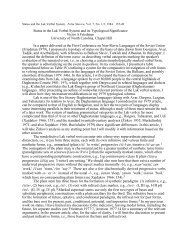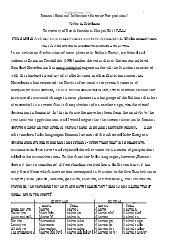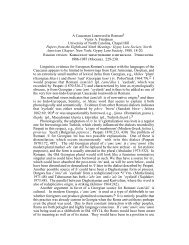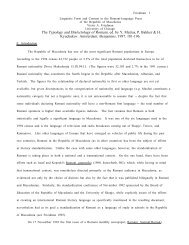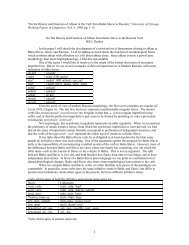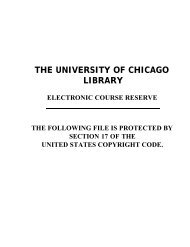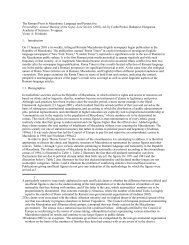Makedonia ve Civar Bölgelerde Balkan Türkçesi / Balkan Turkish in ...
Makedonia ve Civar Bölgelerde Balkan Türkçesi / Balkan Turkish in ...
Makedonia ve Civar Bölgelerde Balkan Türkçesi / Balkan Turkish in ...
You also want an ePaper? Increase the reach of your titles
YUMPU automatically turns print PDFs into web optimized ePapers that Google loves.
1<br />
<strong>Makedonia</strong> <strong>ve</strong> <strong>Civar</strong> Bölgelerde <strong>Balkan</strong> Türkçesi / <strong>Balkan</strong> <strong>Turkish</strong> <strong>in</strong> Macedonia and Adjacent<br />
Areas. Türkler Vol. 20: Türk Topluluklarπ / The Turks, Vol. 6: <strong>Turkish</strong> World, ed. by Hasan<br />
Celâl Güzel et al.. Ankara: Yeni Türkiye. 2002. 455-463 / 609-616. [published simulataneously <strong>in</strong><br />
<strong>Turkish</strong> and English].<br />
<strong>Balkan</strong> <strong>Turkish</strong> <strong>in</strong> Macedonia and Adjacent Areas<br />
Victor A. Friedman<br />
Uni<strong>ve</strong>rsity of Chicago<br />
Studies of the impact of <strong>Turkish</strong> on the <strong>Balkan</strong> languages are among the first associated<br />
with the field of <strong>Balkan</strong> l<strong>in</strong>guistics (Miklosich 1884), and while there are many works about the<br />
<strong>in</strong>fluence of <strong>Turkish</strong> on the <strong>Balkan</strong> languages (see Hazai and Kappler 1999, Jasˇar-Nasteva<br />
2001), studies of <strong>in</strong>fluence <strong>in</strong> the opposite direction are less common (Tietze 1957, Jasˇar-<br />
Nasteva 1957, Kakuk 1972, Ibrahimi 1982, Jusuf 1987, Teodosijevic´ 1985, 1987, 1988,<br />
Johanson 1992, Matras 1990, 1996 ), and descriptions of <strong>Balkan</strong> <strong>Turkish</strong> dialects (mostly from<br />
Bulgaria; Erimer 1970, Gülensoy 1981, Hasan 1987) ha<strong>ve</strong> generally not exam<strong>in</strong>ed contact<br />
phenomena as such. This article treats the <strong>Turkish</strong> dialects of the Republic of Macedonia<br />
classified as part of West Rumelian <strong>Turkish</strong> (Németh 1956; henceforth WRT) -- with references<br />
to adjacent areas where appropriate -- <strong>in</strong> the context of language contact. (For comprehensi<strong>ve</strong><br />
bibliographies of WRT see Hazai 1978:115-22, Tryjarski 1976, 1990, but also Asım 1976,<br />
Doerfer 1959, Eren 1968, Gülensoy 1993, Hafız 1976, Jasˇar-Nasteva 1971/72, Jusuf 1987,<br />
Pokrovskaja 1964, 1974, 1979, Schmaus 1968).<br />
Before the 1999 NATO bomb<strong>in</strong>g of Kosovo, four-fifths of ex-Yugoslavia's Turks li<strong>ve</strong>d <strong>in</strong><br />
Macedonia (78,019, constitut<strong>in</strong>g 4% of the Republic's population accord<strong>in</strong>g to the 1994 census).<br />
That number is now probably higher. I will exclude from consideration here the Yuruk (Yürük,<br />
Yörük) dialects spoken <strong>in</strong> about 65 villages <strong>in</strong> southeastern Macedonia (Nedkov 1986). These<br />
dialects are close to standard <strong>Turkish</strong> and do not differ significantly from it probably ow<strong>in</strong>g to<br />
the relati<strong>ve</strong>ly late arrival of the Yuruks, their relati<strong>ve</strong> isolation <strong>in</strong> mounta<strong>in</strong> villages, and their<br />
practice of endogamy (Jasˇar-Nasteva 1986, Manevic´ 1953-54) . Yuruk tradition holds that<br />
other <strong>Turkish</strong>-speakers <strong>in</strong> Macedonia are Islamicized and subsequently Turkicized<br />
autochthonous populations, which may relate to the contact features of WRT (Palikrusˇeva<br />
1986).<br />
Dur<strong>in</strong>g the Ottoman period, <strong>Turkish</strong> was the language of the towns, especially the market<br />
place and adm<strong>in</strong>istration as well as of some villages. <strong>Turkish</strong> reta<strong>in</strong>ed its prestige among urban<br />
dwellers well <strong>in</strong>to the twentieth century (Jasˇar-Nasteva 1992) and e<strong>ve</strong>n today <strong>in</strong> Macedonia and<br />
Kosova (Akan 2000). <strong>Turkish</strong> rema<strong>in</strong>s vital, especially <strong>in</strong> Western Macedonia, and the <strong>Balkan</strong><br />
<strong>Turkish</strong> l<strong>in</strong>guistic contact environment is replicated despite the sociol<strong>in</strong>guistic shift of <strong>Turkish</strong><br />
from dom<strong>in</strong>at<strong>in</strong>g to dom<strong>in</strong>ated language.<br />
The complex sociol<strong>in</strong>guistic situation raises the question of whose dialect of <strong>Turkish</strong> is to<br />
be taken as <strong>Balkan</strong> <strong>Turkish</strong>. O<strong>ve</strong>r 22,000 declared knowledge of <strong>Turkish</strong> <strong>in</strong> addition to their first<br />
language <strong>in</strong> the 1994 Macedonian census, mak<strong>in</strong>g <strong>Turkish</strong> the most widely declared additional<br />
language after Macedonian and English. The majority of Albanians and Roms <strong>in</strong> Macedonia and<br />
Kosova are Muslim and many speak <strong>Turkish</strong>. The Aromanian and Megleno-Romanian -speak<strong>in</strong>g<br />
Muslims of Macedonia almost all emigrated to Turkey, but the Christian Vlahs are concentrated<br />
<strong>in</strong> areas where Turks are also numerous (<strong>in</strong> southwest and southeast Macedonia). People from<br />
old urban families often speak <strong>Turkish</strong> regardless of religion or ethnicity. <strong>Balkan</strong> <strong>Turkish</strong> as<br />
spoken by non-Turks has undoubtedly <strong>in</strong>fluenced local <strong>Turkish</strong> (cf. Hazai 1963).
Németh's (1956) classic division of <strong>Balkan</strong> <strong>Turkish</strong> <strong>in</strong>to East and West Rumelian dialects<br />
corresponds roughly to the l<strong>in</strong>e that divides East and West Bulgarian dialects (Hazai 1961).<br />
Thus all of Macedonia (except the Yuruk villages) -- as well as Kosova and Albania -- use WRT.<br />
Németh's eight basic WRT features, as summarized by Doerfer (1959), plus two additional<br />
features subsequently suggested elsewhere (Németh 1961:22, Schmaus 1968, Ibrahimi 1982) are<br />
listed below:<br />
1. ı, u, ü -> i <strong>in</strong> word f<strong>in</strong>al position: kutu, subas¸ı, köprü > kuti, subas¸i, küpri<br />
2. The perfect (<strong>in</strong>def<strong>in</strong>ite past) suffix -mis¸ is <strong>in</strong>variant: almis¸, olmis¸, ülmis¸<br />
3. i > ı <strong>in</strong> non<strong>in</strong>itial and closed f<strong>in</strong>al syllables: evim<strong>in</strong> > evımın<br />
4. ö > o˙~o and ü > u˙~u <strong>in</strong> many words: böyle, üç > boyle, uç<br />
5. In suffixes with low vowel harmony (e / a), one of the two forms is generalized:<br />
yemis¸lar, alırse<br />
6. ö -> ü <strong>in</strong> about 40 words: küpri<br />
7. Ottoman g is preser<strong>ve</strong>d consistently: agaç<br />
8. Progressi<strong>ve</strong> <strong>in</strong> -y rather than -yor: yapay, alaysın. (Németh considers the -y progressi<strong>ve</strong><br />
to be deri<strong>ve</strong>d from that <strong>in</strong> -yor, but Doerfer makes the po<strong>in</strong>t that it could be a preservation<br />
from Old Ottoman)<br />
9. The front<strong>in</strong>g of /k/ and /g/ to palatal affricates or stops as a possible n<strong>in</strong>th feature: iki<br />
gece > ik´i g´eg´e (Macedonia) or içi cece (Kosova)<br />
10. The loss of /h/, especially <strong>in</strong> <strong>in</strong>itial position: hoca > oca, also daha > daa, tahta > ta¯ta,<br />
sabah > saba<br />
Subsequent modifications of Németh's classification were proposed by Hazai (1964),<br />
who identifies Goce Delcˇev (Nevrekob) as transitional between east and west, and Mollova<br />
(1970) traces the isogloss for preservation of <strong>in</strong>tervocalic /g/ (agaç 'tree' <strong>ve</strong>rsus aaç, a¯ç) along a<br />
l<strong>in</strong>e from Dolni Ciba˘r on the Danube to Samokov, mov<strong>in</strong>g thence <strong>in</strong> a southwestern direction<br />
north of Blagoevgrad (Cuma-ı Bâlâ) and south of Kocˇani almost to Sˇtip then curv<strong>in</strong>g<br />
southeastward to go south of Radovisˇ then runn<strong>in</strong>g southwest aga<strong>in</strong> to Lake Prespa. When<br />
Hazai and Mollova were writ<strong>in</strong>g, howe<strong>ve</strong>r, works on other WRT dialects such as Jasˇar-Nasteva<br />
(1970), Katona (1969), Kakuk (1972), and Jusuf (1987) were not available. Jusuf (1987:14-16)<br />
dist<strong>in</strong>guishes fi<strong>ve</strong> Kosovan groups -- Prizren-Mamusˇ, Prisˇt<strong>in</strong>a-Janjevo, Mitrovica-Vucˇitrn,<br />
Pec´, Gnjilane-Novobrdo-Dobric´ane (see Hafız 1985, Hasan 1987). Tryjarski (1976, 1990)<br />
notes the need for a revised picture of <strong>Balkan</strong> <strong>Turkish</strong> dialects, and raises the additional problem<br />
that different <strong>in</strong><strong>ve</strong>stigations were conducted at different times. Other studies are unpublished<br />
theses and dissertations at the Uni<strong>ve</strong>rsity of Prisht<strong>in</strong>a. The periodicals Çevren (Kosova), Sesler,<br />
and Sev<strong>in</strong>ç (Macedonia) conta<strong>in</strong> dialect materials and descriptions, and the Skopje newspaper<br />
Birlik occasionally publishes humor columns <strong>in</strong> Skopje, Gostivar or Prizren dialect.<br />
There are almost no data on the <strong>Turkish</strong> dialects of Albania aside from Németh (1961)<br />
and a few works cited by him. In addition to the towns mentioned by Németh -- Tiranë, Krujë<br />
(Akçahisar), Korçë, Elbasan, Lesh, Pogradec (Istarova) and Shkodër -- Turks li<strong>ve</strong> <strong>in</strong> Durrës,<br />
Saranda, Fier, and Elbasan (pace Nemeth 1961:9), but these m<strong>in</strong>orities ha<strong>ve</strong> no official status and<br />
there are no dialect studies. Based on the phonology of Turkisms <strong>in</strong> Albanian (Boretzky 1975)<br />
and the modest data available, these dialects fall with<strong>in</strong> the WRT group.<br />
There are four phonological generalizations that can be made relat<strong>in</strong>g to possible contact<br />
phenomena: high vowel merger, front rounded vowel loss or merger, palatalization of <strong>ve</strong>lars, and<br />
loss of /h/.<br />
2
In the case of Németh's first feature, the shift of all f<strong>in</strong>al high vowels to /i/ could be<br />
connected to the fact that <strong>in</strong> Macedonian /ü/ does not exist and both /u/ and schwa -- the closest<br />
equivalent of /ı/ -- are excluded from nom<strong>in</strong>ati<strong>ve</strong> s<strong>in</strong>gular end<strong>in</strong>gs. While Albanian does ha<strong>ve</strong><br />
phonemic /ü/, it does not nati<strong>ve</strong>ly permit /ü/, /u/, or stressed schwa at the end of <strong>in</strong>def<strong>in</strong>ite nouns<br />
except for a few Tosk monosyllables correspond<strong>in</strong>g to Geg words <strong>in</strong> nasal vowels. A tendency<br />
like that attested <strong>in</strong> Northeast Anatolian could thus ha<strong>ve</strong> been re<strong>in</strong>forced (see below).<br />
A related phenomenon is the conditioned neutralization of the opposition i/ı (Németh's<br />
second feature). Kakuk (1972), Katona (1969), and Jasˇar-Nasteva (1969) make the po<strong>in</strong>t that<br />
Németh's description does not correspond exactly to the situation <strong>in</strong> Western Macedonia. Kakuk<br />
(1972) describes fi<strong>ve</strong> possible realizations of the unrounded high vowel for both back and front<br />
roots: high back unrounded, mid-unrounded, front mid unrounded -- both closed and closed-short<br />
-- and high front unrounded, e.g. gelır/çarır ~ gele˛r/çare˛r ~ gele˙r/çare˙r ~ gelër/çarër ~<br />
gelir/çarir 'comes/calls'. None of the <strong>Balkan</strong> contact languages has a high back unrounded vowel<br />
<strong>in</strong> their phonological <strong>in</strong><strong>ve</strong>ntories except southern Vlah, spoken <strong>in</strong> Epirus, Thessaly, and <strong>in</strong> eastern<br />
Macedonia. Albanian, northern Vlah, and most Macedonian and South Serbian dialects all ha<strong>ve</strong><br />
some sort of schwa, although its realization may vary. In Skopje both Macedonians and Turks<br />
ha<strong>ve</strong> a vowel that is higher and further back than schwa and approaches [i- ]. Stressed schwa <strong>in</strong><br />
Korça Tosk Albanian has a low, front, and open realization approach<strong>in</strong>g [ä]. Moreo<strong>ve</strong>r, the<br />
west-central and peripheral southwestern Macedonian dialects as well as the Macedonian of the<br />
Debar region (but not Debar itself) lack schwa altogether (Friedman 1993b). Accord<strong>in</strong>g to<br />
Katona (1969) the high back unrounded vowel is completely absent <strong>in</strong> some WRT, but Kakuk<br />
(1972) has contradictory data. In any case, like /ö/, <strong>Turkish</strong> /ı/ is <strong>in</strong> a systematically vulnerable<br />
position vis-à-vis the other languages of the <strong>Balkan</strong>s with which it is <strong>in</strong> contact. This is also the<br />
case <strong>in</strong> northeast Anatolian (see below).<br />
The loss of /ö/ and sometimes of /ü/ could be connected to the fact that none of the <strong>Balkan</strong><br />
languages possess /ö/ (except the northern Geg dialects of Albanian) and only Albanian and a few<br />
dialects of other languages <strong>in</strong>fluenced by it ha<strong>ve</strong> /ü/. In the different <strong>Balkan</strong> dialects there is<br />
considerable variation regard<strong>in</strong>g how these sounds are elim<strong>in</strong>ated. Thus, for example öyle, s¸öyle<br />
'thus' > ü¯le, s¸ü¯le <strong>in</strong> Skopje, oyle, s¸ule, <strong>in</strong> Ohrid and Resen, dört 'four' > dert <strong>in</strong> Prizren, dort <strong>in</strong><br />
Gostivar, Ohrid, Skopje (Ago 1987, Kakuk 1972, Hazai 1959/60, Katona 1969, Jasˇar-Nasteva<br />
1970, Jusuf 1987). Jasˇar-Nasteva (1969) makes precisely this po<strong>in</strong>t concern<strong>in</strong>g the restructur<strong>in</strong>g<br />
of the Gostivar <strong>Turkish</strong> vocalic system. Ibrahimi (1982) obser<strong>ve</strong>s that Albanians speak<strong>in</strong>g<br />
<strong>Turkish</strong> ha<strong>ve</strong> /ü/ while Macedonian Muslims ha<strong>ve</strong> only /u/.<br />
The loss of /h/ is shared with local Slavic and Albanian dialects, especially <strong>in</strong>itially and<br />
<strong>in</strong>tervocalically, e.g. WRT hoca 'teacher'> oca, cf. Macedonian hodi 'goes'> odi, Albanian huti<br />
'owl' > uti; WRT daha 'more' > daa cf. Macedonian snaha 'daughter-<strong>in</strong>-law' > snaa; but unlike<br />
those languages, there are no WRT de<strong>ve</strong>lopments of /h/ <strong>in</strong>to /f/ f<strong>in</strong>ally and before consonants, e.g.<br />
Macedonia beh 'I was' > bef, tahta 'board' > tafta, Albanian shoh 'I see' > shof, but WRT sabah<br />
'morn<strong>in</strong>g' > saba, tahta > ta¯ta. Németh (1956:21) po<strong>in</strong>ts out that /h/-loss is an extremely<br />
complicated phenomenon manifested <strong>in</strong> various ways <strong>in</strong> much of the <strong>Turkish</strong> speech area, but it<br />
is particularly characteristic of WRT, especially <strong>in</strong> Macedonia and Kosova, where the contact<br />
languages also elim<strong>in</strong>ate /h/ from their phonological systems (cf. Kowalski 1926, Boretzky<br />
1975:153-4, 164-6, Zekeriya 1971:36, 56, Eren 1968).<br />
The palatalization of /k/ and /g/ before front vowels, and especially the similarity of<br />
articulation <strong>in</strong> local WRT and Slavic and Albanian dialects, is probably <strong>in</strong>fluenced by contact.<br />
The greatest neutralization of the opposition between palatal and <strong>ve</strong>lar before front vowel occurs<br />
3
precisely where the same neutralization occurs <strong>in</strong> Slavic and Albanian, e.g. Kosova and Prilep.<br />
Moreo<strong>ve</strong>r, the quality of the palatals <strong>in</strong> the WRT dialects is the same as <strong>in</strong> the non-<strong>Turkish</strong><br />
contact languages. The automatic palatalization of <strong>ve</strong>lars before front vowels is characteristic of<br />
Standard <strong>Turkish</strong>, but the change from palatalized <strong>ve</strong>lars to palato-<strong>ve</strong>lars (k´, g´ ), palatal<br />
affricates (cˇ/c´, dzˇ, dz´ ) or palatal stops (t´, d´), while also a feature of northeast Anatolian<br />
<strong>Turkish</strong>, is characteristic of WRT on the <strong>Balkan</strong> Pen<strong>in</strong>sula (Németh 1961), and Hafız (1985),<br />
Ibrahimi (1982), Jasˇar-Nasteva (1969), and Jusuf (1978) all identify this as particularly<br />
characteristic of WRT (cf. also Asım 1976, Kakuk 1972, Katona 1969, Zaja˛czkowski 1968).<br />
Elim<strong>in</strong>ation of front rounded vowels, neutralization of high vowels (especially the high<br />
back unrounded), and palatalization of <strong>ve</strong>lars before front vowels (as well as peculiarities <strong>in</strong><br />
vowel harmony) all occur <strong>in</strong> Northeast Anatolia (Brendemoen 1984, 1989, 1992, 1996;<br />
Boeschoeten 1991; cf. also Johanson 1978/79, 1992:227). This raises the question of parallel<br />
de<strong>ve</strong>lopment or con<strong>ve</strong>rgence under respecti<strong>ve</strong> contact situations <strong>ve</strong>rsus a common heritage of<br />
<strong>in</strong>novation due to a northeast Anatolian orig<strong>in</strong> for WRT. Németh (1961) suggests the possibility<br />
of a northeast Anatolian orig<strong>in</strong> for the WRT dialects, but as Brendemoen has shown, these<br />
dialects themsel<strong>ve</strong>s display contact features <strong>in</strong> which Greek may ha<strong>ve</strong> played an conspicuous,<br />
perhaps e<strong>ve</strong>n substratal, role. This comb<strong>in</strong>ed with the Yuruk tradition that the WRT dialects are<br />
spoken by Islamicized autochthonous populations suggests that parallel de<strong>ve</strong>lopment may be the<br />
explanation for the similarities.<br />
An unquestionable contact phenomenon <strong>in</strong> WRT is phonemic /c/=[ts], which occurs <strong>in</strong> all<br />
the relevant contact languages and dialects and is found not only <strong>in</strong> loanwords but also <strong>in</strong><br />
producti<strong>ve</strong> affixes: lonats 'cup', tsapo 'goat', dayitsa 'aunt' (< dayı 'uncle'), okuydzˇitsa (=okuyucu)<br />
'woman who <strong>in</strong>vites one to a wedd<strong>in</strong>g' (Jasˇar-Nasteva 1970). F<strong>in</strong>al devoic<strong>in</strong>g of /g, v, z/, e.g. yus<br />
for yüz 'one hundred' (Jusuf 1987:73) occurs <strong>in</strong> both Macedonian and local Albanian (not <strong>in</strong><br />
Serbian).<br />
Ibrahimi (1982) associates the <strong>ve</strong>larization of clear /l/ after a front vowel if followed by<br />
pause or consonant, e.g. [bü¬bü¬] for bülbül 'night<strong>in</strong>gale', with Macedonian Muslim <strong>Turkish</strong>, e.g.<br />
[bu¬bu¬] as opposed to Macedonian <strong>Turkish</strong> [bü¬bül], Kosovan <strong>Turkish</strong>, [bülbül]. Although<br />
both Macedonian and Albanian ha<strong>ve</strong> a phonemic contrast between clear /l/ and <strong>ve</strong>lar /¬/, the<br />
contrast has an extremely low functional load <strong>in</strong> Macedonian, and for the most part the two<br />
sounds are <strong>in</strong> complementary distribution (only rarely does /l/ occur before a consonant, back<br />
vowel, or word f<strong>in</strong>ally). In Albanian, howe<strong>ve</strong>r, the two sounds are contrasted <strong>in</strong> all<br />
environments. In WRT <strong>in</strong> Macedonia, the tendency is to treat /l/ accord<strong>in</strong>g to Macedonian rather<br />
than <strong>Turkish</strong> distributional rules, whereas <strong>in</strong> Kosova, where Albanian is the dom<strong>in</strong>ant contact<br />
language, such is not the case.<br />
Other phenomena reported by Jasˇar-Nasteva (1969) and Jusuf (1988:67-68) as result<strong>in</strong>g<br />
from contact are loss of gem<strong>in</strong>ates (elli 'fifty' > eli) and toleration of <strong>in</strong>itial clusters (spanak vs<br />
ıspanak 'sp<strong>in</strong>ach').<br />
In morphophonology, lack of vowel harmony may be a contact <strong>in</strong>duced phenomenon, but<br />
the evidence is ambiguous. While lack of vowel harmony <strong>in</strong> the contact languages could <strong>in</strong>fluence<br />
the generalization of a gi<strong>ve</strong>n affix or the confusion of font/back or labial/non-labial harmony, some<br />
of these features could be archaisms preser<strong>ve</strong>d ow<strong>in</strong>g to lack of contact with the <strong>in</strong>novat<strong>in</strong>g<br />
dialects. Aga<strong>in</strong>, the similarity to northeast Anatolian raises the question of parallel archaism,<br />
parallel de<strong>ve</strong>lopment, or actual connection (Johanson 1978/79, 1992:223, Brendemoen 1992,<br />
Boeschoeten 1991).<br />
4
For <strong>in</strong>flection, the vocati<strong>ve</strong> suffix -o, e.g. babo ' O father', abo 'O older brother', etc.<br />
(Bayram 1985), could be treated as a borrowed affix, but the examples are limited to <strong>in</strong>dividual<br />
lexical items and can be treated as borrowed expressions. The -y progressi<strong>ve</strong> is not a contact<br />
phenomenon, nor is it characteristic of all of WRT (Jasˇar-Nasteva 1970, Kakuk 1972, Mollova<br />
1962).<br />
Derivational morphology shows a number of borrow<strong>in</strong>gs, especially Slavic markers of<br />
fem<strong>in</strong><strong>in</strong>e nouns (-ka, -itsa)and dim<strong>in</strong>uti<strong>ve</strong>s (-çe), e.g. baldıska 'wife's sister' (< baldız), dayitsa<br />
'aunt' (< dayı 'uncle'), (Jasˇar-Nasteva 1970), dim<strong>in</strong>uti<strong>ve</strong> <strong>in</strong>sançe 'person' (Kakuk 1972), Memetçe<br />
'Mehmet' (Mollova 1968:119). Albanian does not appear to ha<strong>ve</strong> contributed to this<br />
morphology, perhaps because such markers are more subtle (fem<strong>in</strong><strong>in</strong>e markers -ë, -e),<br />
phonologically alien (dim<strong>in</strong>uti<strong>ve</strong> -th), or themsel<strong>ve</strong>s borrowed from Slavic (dim<strong>in</strong>uti<strong>ve</strong> -kë/-ka).<br />
The three most producti<strong>ve</strong> <strong>Turkish</strong> suffixes <strong>in</strong> non-<strong>Turkish</strong> <strong>Balkan</strong> languages, mutatis<br />
mutandis, -ci, -li, and -lik (Friedman 1996) are also more producti<strong>ve</strong> <strong>in</strong> WRT than <strong>in</strong> Standard<br />
<strong>Turkish</strong> as a result of contact, e.g. aks¸amlık <strong>in</strong> the mean<strong>in</strong>g 'e<strong>ve</strong>n<strong>in</strong>g meal' < Serbian aksˇamluk<br />
vs. Standard <strong>Turkish</strong> aks¸am yemeg˘i, devletçi 'statesman' vs devlet adamı (cf. Teodosijevic´<br />
1985, 1987, 1988, also Mollova 1968:118).<br />
The most strik<strong>in</strong>g WRT morphosyntactic nom<strong>in</strong>al features of contact orig<strong>in</strong> are<br />
dati<strong>ve</strong>/locati<strong>ve</strong> confusion, number agreement between demonstrati<strong>ve</strong>s and nouns, and geniti<strong>ve</strong>head<br />
re<strong>ve</strong>rsal.<br />
In Macedonian, and Albanian the mean<strong>in</strong>g of 'motion toward' and 'location' are carried by<br />
the same prepositions, e.g. Macedonian zˇi<strong>ve</strong>e/odi vo Skopje, Albanian banon/shkon në Shkup<br />
'He li<strong>ve</strong>s <strong>in</strong> Skopje'/'He goes to Skopje', and <strong>in</strong> Serbian the dati<strong>ve</strong> and locati<strong>ve</strong> cases ha<strong>ve</strong> merged.<br />
Although Kakuk 1972 reports occasional dati<strong>ve</strong> for locati<strong>ve</strong>, it is usually the locati<strong>ve</strong> case which<br />
is generalized <strong>in</strong> WRT, as <strong>in</strong> example (1):<br />
(1) Üsçüp'te cidam (=Üsküb'e gidelim) (Jusuf 1987:89) 'let's go to Skopje'<br />
In the contact languages, the orig<strong>in</strong>al mean<strong>in</strong>gs of the relevant prepositions were locati<strong>ve</strong>, and this<br />
comb<strong>in</strong>ed with the fact that the <strong>Turkish</strong> locati<strong>ve</strong> case suffix has the same phonological CV<br />
structure as the correspond<strong>in</strong>g prepositions may ha<strong>ve</strong> contributed to the choice of case for<br />
generalization.<br />
A phenomenon implicitly recognized as occurr<strong>in</strong>g <strong>in</strong> WRT <strong>in</strong> textbooks <strong>in</strong>tended for<br />
<strong>Turkish</strong> schools <strong>in</strong> Macedonia and Kosova is the use of the plural suffix on modifiers of plural<br />
nouns, e.g. bunlar çocuklar <strong>in</strong>stead of bu çocuklar (Yusuf 1971:47) 'these children' on the model<br />
of Macedonian ovie deca, Albanian këta fëmijë, etc. <strong>in</strong> which both the modifier and the noun<br />
carry morphological markers of plurality. The fact that <strong>Turkish</strong> children <strong>in</strong> Macedonia and<br />
Kosova are told that such agreement is 'wrong' is <strong>in</strong>dicates that they use it.<br />
The re<strong>ve</strong>rsal of geniti<strong>ve</strong> and head <strong>in</strong> possessi<strong>ve</strong> izafet constructions, e.g., familiasi adamën<br />
'the family of the man' (Katona 1969:165), babasi Al<strong>in</strong><strong>in</strong> 'the father of Ali' (Ibrahimi 1982) as<br />
opposed to Standard <strong>Turkish</strong> adamın familiası, Ali'n<strong>in</strong> babası, are patterned after the Indo-<br />
European contact languages, e.g. Albanian familje i njeriut, babai i Aliut, Macedonian familijata<br />
na cˇo<strong>ve</strong>kot, tatko mu na Ali. (Macedonian and Bulgarian also permit head-geniti<strong>ve</strong> word order,<br />
which is atypical for Slavic, e.g. na Ali tatko mu.)<br />
Morphosyntactic contact phenomena <strong>in</strong> the <strong>ve</strong>rb-phrase reflect tendencies to elim<strong>in</strong>ate<br />
non-f<strong>in</strong>ite forms and mo<strong>ve</strong> <strong>in</strong> a direction from agglut<strong>in</strong>ation toward analyticity. Both tendencies<br />
are also characteristic of the Indo-European <strong>Balkan</strong> languages from which the WRT constructions<br />
are evidently calqued. These tendencies are realized by substitut<strong>in</strong>g the optati<strong>ve</strong>-subjuncti<strong>ve</strong> or<br />
5
conditional for the <strong>in</strong>f<strong>in</strong>iti<strong>ve</strong>, by substitut<strong>in</strong>g lexical items or phrases for affixes of <strong>in</strong>terrogation<br />
and negativity, and by replac<strong>in</strong>g participial constructions with connectors plus f<strong>in</strong>ite <strong>ve</strong>rb forms.<br />
Matras (1990, 1996) analyzes the orig<strong>in</strong> and significance of the replacement of <strong>in</strong>f<strong>in</strong>itival<br />
clauses by subjuncti<strong>ve</strong> ones <strong>in</strong> Macedonian WRT, a phenomenon that is well attested <strong>in</strong> WRT <strong>in</strong><br />
general (Mollova 1968, Jasˇar-Nasteva 1970, Eckmann 1962, Kakuk 1960, 1972, Németh<br />
1965:97,109) as well as <strong>in</strong> East Rumelian <strong>Turkish</strong> and Gagauz (Mollova 1962, Guzev 1962,<br />
Mollov and Mollova 1966, Gajdarzˇi 1973, Pokrovskaja 1964:210, 1979). The use of the<br />
optati<strong>ve</strong>-subjuncti<strong>ve</strong> or 3 sg imperati<strong>ve</strong> to express <strong>in</strong>direct imperati<strong>ve</strong>s and clauses of goal also<br />
occurs <strong>in</strong> other Turkic languages and dialects (Kakuk 1960, Mollov and Mollova 1966), but the<br />
far greater frequency and wider range of such uses <strong>in</strong> <strong>Balkan</strong> <strong>Turkish</strong> <strong>in</strong>dicate the <strong>in</strong>fluence of<br />
non-<strong>Turkish</strong> <strong>Balkan</strong> languages. The expanded <strong>Turkish</strong> usage seems calqued from subord<strong>in</strong>ate<br />
clauses <strong>in</strong> Macedonian and Albanian us<strong>in</strong>g the particles da and të, respecti<strong>ve</strong>ly, which can<br />
function <strong>in</strong> subjuncti<strong>ve</strong>, optati<strong>ve</strong>, and conditional contexts <strong>in</strong> their respecti<strong>ve</strong> languages (see<br />
Friedman 1985). The follow<strong>in</strong>g examples with expressions of necessity are typical of WRT<br />
usage and are gi<strong>ve</strong>n with their Macedonian and Albanian equivalents:<br />
(2) Lâzım gideyim (Zekeriya 1978:.38) Treba da odam/Duhet të shkoj 'I ha<strong>ve</strong> to go'<br />
(3) O köylerde läzım büyük agitatsiya yapılsın (Jasˇar-Nasteva 1957:149) vo tie sela<br />
treba da se napravi golema agitatsija/në këta fshatra duhet të bëhet agjitacion i madh '<strong>in</strong><br />
those villages some major consciousness rais<strong>in</strong>g needs to be done'<br />
Examples (4)-(5) show the optati<strong>ve</strong>-subjuncti<strong>ve</strong> and (6) the conditional after various f<strong>in</strong>ite <strong>ve</strong>rbs<br />
that would take <strong>in</strong>f<strong>in</strong>itval clauses <strong>in</strong> Standard <strong>Turkish</strong> but da/të clauses <strong>in</strong> Macedonian and<br />
Albanian:<br />
(4) Çocok celdi ekmek alsın (Jusuf 1987:132) 'The child came to get bread'<br />
(5) Bas¸layacam çalıs¸am (Zekeriya 1976:.7) 'I'll beg<strong>in</strong> to work'<br />
(6) Bas¸ladi yalan söylesa (Kakuk 1972:246) 'he began to tell lies'<br />
Examples (7) and (8) represent calques on Slavic. In example (7) the <strong>Turkish</strong> <strong>in</strong>terrogati<strong>ve</strong>possibiliti<strong>ve</strong><br />
is replaced by the dialectal equivalent of Standard <strong>Turkish</strong> olur mu modeled on<br />
Slavic mozˇe li 'is it possible?', while <strong>in</strong> (8) the Macedonian negati<strong>ve</strong> future, which is formed by a<br />
negati<strong>ve</strong> existential plus a da-clause (subjuncti<strong>ve</strong>) has been calqued by an equivalent construction<br />
<strong>in</strong> WRT:<br />
(7) Olor mi sizde celam (Yusuf 1977:67)=Size gelebilir miyiz/Mozˇe li kaj vas da<br />
dojdeme 'Can we come to your place'<br />
(8) Yoktur bizimle geles<strong>in</strong> (Zekeriya 1976:.10)=Bizimle gelmiyeceks<strong>in</strong>/Nema so nas da<br />
odisˇ 'You won't come [with us]<br />
The calqu<strong>in</strong>g and borrow<strong>in</strong>g of various conjunctions <strong>in</strong> WRT results <strong>in</strong> the reduction or<br />
elim<strong>in</strong>ation of participial constructions. Syntactic calqu<strong>in</strong>g of relativiz<strong>in</strong>g and coord<strong>in</strong>at<strong>in</strong>g<br />
conjunctions is also discussed <strong>in</strong> Matras (1996; see also Johanson 1975). Of particular <strong>in</strong>terest is<br />
the use of ne 'what' as a relativizer modeled on Macedonian sˇto as illustrated <strong>in</strong> examples (9)-<br />
(10):<br />
(9) çocoklar yemis¸lar pogaçay em oumay ne cetırdım. (Jusuf 1987:108). 'The children<br />
ha<strong>ve</strong> eaten the round loaf and apple that I brought.'<br />
(10) Cetır o çitabi ne <strong>ve</strong>rdım sana (Sana <strong>ve</strong>rdig˘im kitabı getir) (Yusuf 1977:65) 'Br<strong>in</strong>g that<br />
book which I ga<strong>ve</strong> you<br />
The use of ne zaman 'when?' as a calque on Macedonian koga Albanian kur 'when' as a relativizer<br />
as well as an <strong>in</strong>terrogati<strong>ve</strong> also ser<strong>ve</strong>s to elim<strong>in</strong>ate participial constructions (Kakuk 1972, Németh<br />
1965:110, Mollov and Mollova 1966),<br />
6
(11) Ne zaman gittik s<strong>in</strong>emaya. . . (Zekeriya 1976:.10-2) 'When(e<strong>ve</strong>r) we went to the<br />
movies. . .'<br />
Particularly <strong>Balkan</strong> is the use of niç<strong>in</strong> 'why' to mean 'because' as well, this be<strong>in</strong>g a calque on<br />
colloquial usages of Macedonian zosˇto/zasˇto, Albanian pse , etc. as <strong>in</strong> the follow<strong>in</strong>g example:<br />
(12) Sıkılmıs¸ niç<strong>in</strong> padis¸adan bir ay mektup yogimis¸ (Kakuk 1972:261) 'she was<br />
worried because she hadn't had a letter from the padishah for a month<br />
In addition to calques, borrowed conjunctions such as Albanian se 'that, for' and Slavic a 'and/but'<br />
are used as <strong>in</strong> the follow<strong>in</strong>g examples (cf. Matras 1996):<br />
(13) Bu cece celemem se çok var isım (Yusuf 1977:67) 'I can't come this e<strong>ve</strong>n<strong>in</strong>g because I<br />
ha<strong>ve</strong> a lot of work'<br />
(14) Bu adamın karisi ülmis¸ a çocogi ufak kalmis¸ 'This man's wife died, and left the little<br />
child'<br />
Johanson (1975) and Matras (1996) raise the question of whether or not the calqued<br />
constructions represent genu<strong>in</strong>e hypotaxis and the discourse motivations for us<strong>in</strong>g borrowed<br />
conjunctions. These examples nonetheless represent simplifications <strong>in</strong> the WRT <strong>in</strong>flectional<br />
system which, by elim<strong>in</strong>at<strong>in</strong>g participial forms <strong>in</strong> favor of constructions with f<strong>in</strong>ite <strong>ve</strong>rbs br<strong>in</strong>g it<br />
closer to the <strong>Balkan</strong> languages with which it is <strong>in</strong> contact.<br />
WRT word order is also <strong>in</strong>fluenced by contact. While colloquial Standard <strong>Turkish</strong><br />
permits considerably more variation <strong>in</strong> word order than formal written style, WRT has unmarked<br />
word orders that would be marked <strong>in</strong> standard <strong>Turkish</strong>, and this is under the <strong>in</strong>fluence of the<br />
Indo-European contact languages (which also ha<strong>ve</strong> considerable freedom for marked word orders).<br />
Thus, for example, from the po<strong>in</strong>t of view of Standard <strong>Turkish</strong> there is noth<strong>in</strong>g grammatically<br />
wrong with the sentence Erol'dur iyi ög˘renci (Zekeriya 1976:7). The dialectal feature is the<br />
fact that it is the unmarked WRT equivalent of the English 'Erol is a good student' (Macedonian<br />
Erol e dobar ucˇenik), whereas <strong>in</strong> standard <strong>Turkish</strong> it would ha<strong>ve</strong> a mean<strong>in</strong>g more like ‘It is Erol<br />
who is the good student’. Thus, the <strong>ve</strong>rb <strong>in</strong> WRT occurs at the beg<strong>in</strong>n<strong>in</strong>g of the sentence or <strong>in</strong><br />
some other nonf<strong>in</strong>al position far more than <strong>in</strong> Standard <strong>Turkish</strong> (Jusuf 1988:132, Jasˇar-Nasteva<br />
1970, Katona 1969, also Mollov and Mollova 1966 for East Rumelian <strong>Turkish</strong> and Doerfer 1959,<br />
Pokrovskaja 1979 for Gagauz). The follow<strong>in</strong>g examples are typical of WRT dialectal word order<br />
under Slavic or Albanian <strong>in</strong>fluence (See Teodosijevic´ 1985 for other examples):<br />
(15) Babasi Al<strong>in</strong><strong>in</strong> her gün gider pazara als<strong>in</strong> alma. (Ibrahimi 1982:53) 'Ali's father goes to<br />
the market e<strong>ve</strong>ry day to buy apples'<br />
(16) Açan id<strong>in</strong> Ohri'de (Zekeriya and Bugariç 1976:.14) 'When were you <strong>in</strong> Ohrid?'<br />
(17) Oynadilar çoceklar bütün cün sokakta 'The children played all day <strong>in</strong> the street'<br />
(Jusuf 1987:132)<br />
The lexicon of WRT is heavily <strong>in</strong>fluenced by contact languages (Jasˇar-Nasteva 1957,<br />
1970), which is expected, gi<strong>ve</strong>n its current sociol<strong>in</strong>guistic situation. In Bulgaria, the go<strong>ve</strong>rnment<br />
went so far as to campaign to <strong>in</strong>crease the number of Bulgarian words <strong>in</strong> local <strong>Turkish</strong> dialects by<br />
publish<strong>in</strong>g lists of "forbidden" <strong>Turkish</strong> words and their "correct" Bulgarian replacements (see<br />
Rud<strong>in</strong> & Em<strong>in</strong>ov 1993). Dur<strong>in</strong>g the 1980’s, Macedonia, whose language policies with regard to<br />
m<strong>in</strong>orities are <strong>in</strong> general considerably better than those of its neighbors, <strong>in</strong>terfered <strong>in</strong> pr<strong>in</strong>t media<br />
regard<strong>in</strong>g the use of <strong>Turkish</strong> (and Albanian) toponyms of places located <strong>in</strong> Macedonia, e.g.<br />
<strong>in</strong>sist<strong>in</strong>g on Macedonian Bitola <strong>ve</strong>rsus <strong>Turkish</strong> and Albanian Manastir (Friedman 1993a). For the<br />
WRT dialects of Macedonia, there are lexical phenomena that are more specific to their<br />
environment and not common to e<strong>ve</strong>ry contact situation. For neologisms, WRT pr<strong>in</strong>t media are<br />
sometimes "more Catholic than the Pope.” A neologistic word may fail to ga<strong>in</strong> currency <strong>in</strong><br />
7
Turkey but be ma<strong>in</strong>ta<strong>in</strong>ed <strong>in</strong> WRT pr<strong>in</strong>t media, e.g. nen 'th<strong>in</strong>g' <strong>ve</strong>rsus the Standard <strong>Turkish</strong><br />
Arabism s¸ey (Teodosijevic´ 1987:187). A lexical feature of colloquial WRT that is specific to its<br />
context is the reborrow<strong>in</strong>g of words that the contact languages orig<strong>in</strong>ally borrowed and<br />
subsequently altered. Thus the "Turkisms" of Macedonian and Albanian become "contact"<br />
elements <strong>in</strong> WRT when it reborrows them, as shown <strong>in</strong> the follow<strong>in</strong>g examples:<br />
(18) piper = biber (Zekeriya 1976:.17, cf. Caferog˘lu 1959:250)<br />
(19) demirliya = demirli 'iron' (Bayram 1985)<br />
The facts of WRT raise a number of <strong>in</strong>terest<strong>in</strong>g questions concern<strong>in</strong>g mechanisms,<br />
effects, and ideology <strong>in</strong> language contact. On the phonological le<strong>ve</strong>l the most noteworthy<br />
phenomena are the elim<strong>in</strong>ation of consonant and vowel phonemes not represented <strong>in</strong> the contact<br />
languages, e.g.. /ö/ and /h/, the migration of high back unrounded /i- / to a more central or otherwise<br />
altered position, and the <strong>in</strong>troduction of a dental affricate /c/. The palatalization of <strong>ve</strong>lars before<br />
front vowels and merger with palatal affricates also parallels processes <strong>in</strong> the contact dialects, as<br />
do phonotactic processes such as the elim<strong>in</strong>ation of gem<strong>in</strong>ates and the treatment of /l/. The<br />
result<strong>in</strong>g phonological <strong>in</strong><strong>ve</strong>ntories of WRT dialects look <strong>ve</strong>ry much like those of the non-<strong>Turkish</strong><br />
dialects with which they are <strong>in</strong> contact.<br />
On the morphophonemic le<strong>ve</strong>l, confusion <strong>in</strong> the system of vowel harmony, while<br />
possibly an archaism, also reflects the lack of vowel harmony <strong>in</strong> the contact languages, WRT<br />
<strong>in</strong>flection has rema<strong>in</strong>ed otherwise unaffected, although the dati<strong>ve</strong>-locati<strong>ve</strong> confusion (generally <strong>in</strong><br />
favor of the locati<strong>ve</strong>) is an <strong>in</strong>terest<strong>in</strong>g counterexample to the claim that the transparency of<br />
<strong>Turkish</strong> <strong>in</strong>flection makes it resistant to contact (cf. Johanson 1992:231). Howe<strong>ve</strong>r, this and the<br />
borrow<strong>in</strong>g of the vocati<strong>ve</strong> affix -- which can be treated as lexical or derivational -- demonstrate<br />
that on the whole the WRT <strong>in</strong>flectional system is remarkably resistant. (The replacement of<br />
nonf<strong>in</strong>ite with f<strong>in</strong>ite clauses also affects <strong>in</strong>flection, but only <strong>in</strong>sofar as there is a shift from<br />
<strong>in</strong>flection to syntax to con<strong>ve</strong>y some types of <strong>in</strong>formation.) The derivational system has been<br />
<strong>in</strong>fluenced precisely <strong>in</strong> those areas where the contact languages differ, e.g. the borrow<strong>in</strong>g of<br />
fem<strong>in</strong><strong>in</strong>e gender markers for animate be<strong>in</strong>gs, or where they are particularly salient, e.g. <strong>in</strong><br />
dim<strong>in</strong>uti<strong>ve</strong> markers. Also of significance may be the exaggerated productivity of nati<strong>ve</strong> affixes<br />
that are borrowed and producti<strong>ve</strong> <strong>in</strong> the contact languages.<br />
The realm of syntax, which is where Standard <strong>Turkish</strong> and the <strong>Balkan</strong> languages display<br />
their most salient differences, shows an especially strong tendency <strong>in</strong> WRT toward<br />
accommodation. In the noun phrase, there is the tendency to confuse dati<strong>ve</strong> and locati<strong>ve</strong> case<br />
functions, to copy patterns of modifier agreement and to use head-geniti<strong>ve</strong> word order. In the<br />
<strong>ve</strong>rb phrase, the tendency is to elim<strong>in</strong>ate nonf<strong>in</strong>ite forms by substitut<strong>in</strong>g <strong>in</strong>flected<br />
(optati<strong>ve</strong>/subjuncti<strong>ve</strong> or conditional) forms for <strong>in</strong>f<strong>in</strong>iti<strong>ve</strong>s and analytic connecti<strong>ve</strong>s for participles.<br />
E<strong>ve</strong>n the <strong>in</strong>flection for <strong>in</strong>terrogation and negativity is sometimes replaced by a lexical items based<br />
on Slavic models. In sentential word order WRT arguably displays strong contact <strong>in</strong>duced<br />
<strong>in</strong>fluence.<br />
In the lexicon, aside from calques and loanwords, some of which ha<strong>ve</strong> affected the<br />
phonological system, there are phenomena specific to the situation of WRT as a formerly<br />
dom<strong>in</strong>ant language now both subord<strong>in</strong>ate and beyond the borders of the centers of<br />
standardization. The phenomenon of reborrow<strong>in</strong>g loanwords <strong>in</strong> the shape they acquired <strong>in</strong> the<br />
languages that orig<strong>in</strong>ally borrowed them reflects a change <strong>in</strong> dom<strong>in</strong>ance relations. Similarly,<br />
whereas <strong>Turkish</strong> was the source for all sorts of expressions <strong>in</strong> Slavic relat<strong>in</strong>g to e<strong>ve</strong>ryth<strong>in</strong>g from<br />
e<strong>ve</strong>ryday life to state adm<strong>in</strong>istration, the opposite is now the case, with Slavic (and, where it is<br />
numerically dom<strong>in</strong>ant, also Albanian) serv<strong>in</strong>g as the source for numerous borrow<strong>in</strong>gs <strong>in</strong>to WRT.<br />
8
9<br />
This br<strong>in</strong>gs us to the question of Slavic <strong>ve</strong>rsus Albanian <strong>in</strong>fluence and the sociol<strong>in</strong>guistic<br />
position of WRT. Particularly <strong>in</strong> Western Macedonia there is a strong competition between<br />
Albanian and Macedonian, one which is already attested at the beg<strong>in</strong>n<strong>in</strong>g of this century<br />
(Selisˇcˇev 1931:11-12). In many cases, either language could ha<strong>ve</strong> been the source of a contact<br />
phenomenon, and <strong>in</strong>sist<strong>in</strong>g on assign<strong>in</strong>g the orig<strong>in</strong> to one or the other language can ha<strong>ve</strong><br />
ideological o<strong>ve</strong>rtones (cf. Ibrahimi 1982). Moreo<strong>ve</strong>r, the fact that <strong>Turkish</strong> was often adopted by<br />
speakers of other languages raises the question of the extent to which WRT can be considered a<br />
"relexified" <strong>Balkan</strong> language.<br />
BIBLIOGRAPHY<br />
Ago, A. 1987. ıs<strong>ve</strong>çte çalıs¸makta olan Makedonya'nın Resne bölges<strong>in</strong>den Türk is¸çi ailer<strong>in</strong><strong>in</strong><br />
konus¸ma dil<strong>in</strong>deki deg˘is¸meler. Bes¸<strong>in</strong>ci milletler arası türkoloji kongresi: Teblig˘ler 1. Türk<br />
dili, cilt 2. Istanbul: ∏stanbul Üni<strong>ve</strong>rsitesi Edebiyat Fakültesi. 7-15.<br />
Akan Ellis, B. 2000. “Shadow Geneologies: Memory and Identity among Urban Muslims <strong>in</strong><br />
Macedonia.” Ph.D. dissertation. The American Uni<strong>ve</strong>rsity.<br />
Asım, M. 1976 "Prizren civarında Mamus¸a Köyünde düg˘ün türküleriæ, I. Uluslararasıtürk<br />
folklor kongresi bildirileri, vol.I.1-7. Ankara: Ankara Üni<strong>ve</strong>rsitesi.<br />
Bayram, I. 1985. Sırp-Hırvat <strong>ve</strong> Arnavut diller<strong>in</strong><strong>in</strong> Kosova Türk Ag˘ızlarına etkisi. (Interview<br />
with Prof. Dr. Nimetullah Hafız). Birlik II/5.15.<br />
Bernsˇtejn, S.B. 1968 "Les langues turkes de la Pén<strong>in</strong>sule des <strong>Balkan</strong>s et l'union des langues<br />
balkaniques", Actes du Premier congrés <strong>in</strong>ternational des études balkaniques et sud-est<br />
européens, vol.VI.73-79. Sofia: BAN.<br />
Birlik. Tri-weekly <strong>Turkish</strong>-language newspaper published <strong>in</strong> Skopje. References ha<strong>ve</strong> the<br />
follow<strong>in</strong>g format: date.month.year:page.<br />
Boeschoten, H. 1991. Aspects of Language Variation. <strong>in</strong>: <strong>Turkish</strong> L<strong>in</strong>guistics Today, ed. by<br />
Hendrik Boeschoten and Ludo Verhoe<strong>ve</strong>n. Leiden: Brill. 150-76.<br />
Boretzky, N. 1975, 1976. Der türkische E<strong>in</strong>fluss auf das Albanische. I-II. Wiesbaden:<br />
Harrassowitz.<br />
Brendemoen, B. 1984. A note on the retraction of labial front vowels <strong>in</strong> the <strong>Turkish</strong> dialet of<br />
Trabzon. Riepmocˇála: Esays <strong>in</strong> honor of Knut Bergsland. Oslo: Novus Forlag. 13-24.<br />
—. 1989. Trabzon Çepni ag˘zı <strong>ve</strong> Tepegöz hikâyes<strong>in</strong><strong>in</strong> bir Çepni varyanı. Trabzon Kültür-<br />
Sanat Yıllıg˘ı 1988-89.13-22.<br />
—. 1996. Phonological Aspects of Greek-<strong>Turkish</strong> Language Contact <strong>in</strong> Trabzon. Conference on<br />
<strong>Turkish</strong> <strong>in</strong> Contact, Netherlands Institute for Advanced Study (NIAS), Wassenaar, 5-6<br />
February, 1996.<br />
—. 1992. Some Remarks on the Vowel Harmony <strong>in</strong> a Religious dialect Text from Trabzon. In:<br />
Altaic Religious Beliefs and Practices, ed. by G. Bethlenfalvy. Budapest: Hungarian Academy<br />
of Sciences. 41-57.<br />
Burgariç, Recep. 1976. Dilimizi ög˘renelim: Sınıf IV. Skopje: Pros<strong>ve</strong>tno Delo.<br />
—. 1978. Dilbilgisi: Sınıf VII Skopje: Pros<strong>ve</strong>tno Delo.<br />
Caferog˘lu, A. 1959 "Die anatolische und rumelische Dialekte", Philologiae Turcicae<br />
Fundamenta, I.239-260. Wiesbaden: Harrassowitz.<br />
—. 1964 "Anadolu <strong>ve</strong> Rumeli ag˘ızları ünlü deg˘is¸meleri", Türk dili aras¸tırmaları yıllıg˘ı<br />
belleten, 1-33.
Doerfer, G. 1959 "Das Gagausische", Philologiae Turcicae Fundamenta, I.260-71. Wiesbaden:<br />
Harrassowitz.<br />
Eckmann, J. 1962 "Kumanova (Makedonya) türk ag˘zı", Németh armag˘anı, 111-144. Ankara.<br />
Eren, ı. 1968. "Manastir Türkler<strong>in</strong><strong>in</strong> bazı Hıdrelez âdetleri", Türk kültürü, 6.557-559.<br />
Erimer, K. 1970 "Anadolu <strong>ve</strong> Rumeli ag˘ızları üzer<strong>in</strong>de bir bibliografya denemesi", Türk dili<br />
aras¸tırmaları yıllıg˘ı belleten, 211-236.<br />
Friedman, V. A. 1982. <strong>Balkan</strong>ology and Turcology: West Rumelian <strong>Turkish</strong> <strong>in</strong> Yugoslavia as<br />
Reflected <strong>in</strong> Prescripti<strong>ve</strong> Grammar. Studies <strong>in</strong> Slavic and General L<strong>in</strong>guistics, Vol. 2,<br />
Amsterdam: Rodopi. 1-77.<br />
—. 1985. <strong>Balkan</strong> Romani Modality and Other <strong>Balkan</strong> Languages. Folia Slavica, 7,3.381-389.<br />
—. 1986. <strong>Turkish</strong> Influence <strong>in</strong> Modern Macedonian: The Current Situation and Its General<br />
Background. Festschrift für Wolfgang Gesemann, Band 3, Beiträge zur slawischen<br />
Sprachwissenschaft und Kulturgeschichte. (Slavische Sprachen und Literaturen Band 8), ed. by<br />
Helmut Schaller. München: Hieronymus. 85-108.<br />
—. 1993a. Language Policy and Language Behavior <strong>in</strong> Macedonia: Background and Current<br />
E<strong>ve</strong>nts. <strong>in</strong>: Language Contact, Language Conflict, ed. by Eran Fraenkel and Christ<strong>in</strong>a Kramer.<br />
Peter Lang: New York. 73-99.<br />
—. 1993b. Macedonian. The Slavonic Languages. ed. by B. Comrie and G. Corbett. London:<br />
Routledge. 249-305.<br />
—. 1996. The <strong>Turkish</strong> Lexical Element <strong>in</strong> the Languages of the Republic of Macedonia from the<br />
Ottoman Period to Independence. Zeitschrift für <strong>Balkan</strong>ologie. Vol. 32.<br />
Gadzˇieva, N. Z. 1973. Osnovny puti razvitija s<strong>in</strong>taksicˇeskoj struktury tjurkskix jazykov.<br />
Moscow: Nauka.<br />
Gajdarzˇi, G.A. 1973 Gaguzskij s<strong>in</strong>taksis. Kis¸<strong>in</strong>a˘u: S¸ti<strong>in</strong>t¸a.<br />
Gülensoy, T. 1981 Anadolu <strong>ve</strong> Rumeli ag˘ızları bibliografyası. (Millî folklor aras¸tırma dairesi<br />
yayınları, No.33). Ankara: Kültür Bakanlıg˘ı.<br />
—. 1993. Rumeli Ag˘ızlarının ses bilgisi üzer<strong>in</strong>e bir deneme. Kayseri: Erciyes Üni<strong>ve</strong>rsitesi.<br />
Guzev, V.G. 1962 "Opisanie tureckogo govora sela Krepcˇa tyrgovisˇtenskogo okruga v<br />
Bolgarii", <strong>Balkan</strong>sko ezikoznanie 5,2.57-85.<br />
Hafız, N. 1985. Kosova türk ag˘ızlarında "k > ç" <strong>ve</strong> "g > c" ünsüz deg˘is¸meleri. Bes¸<strong>in</strong>ci<br />
milletler arası türkoloji kongresi: Teblig˘ler 1. Türk dili, cilt 1. Istanbul: ∏stanbul<br />
Üni<strong>ve</strong>rsitesi Edebiyat Fakültesi. 127-29.<br />
Hafız, T. 1976 "Prizren'de türk halk türküleri <strong>ve</strong> kaynakları", Türk folkloru aras¸tırmaları<br />
yıllıg˘ı, 116-140.<br />
Hasan, H. 1987. Yugoslavya'de Türk halk edebiyatı üzer<strong>in</strong>de yapılan derleme çeviri <strong>ve</strong><br />
aras¸tırmalar üzer<strong>in</strong>de bir bibliografya. Türk dili aras¸tırmaları yıllıg˘ı Belleten. (1984). 315-38<br />
Hazai, G. 1959/60 "Beiträge zur Kenntnis der türkischen Mundarten Mazedoniens", Rocznik<br />
orientalistyczny, 23,2.83-100.<br />
—. 1961 "Contributions à l'histoire d'une limite dialectale dans les <strong>Balkan</strong>s", Orbis, 10.15-19.<br />
—. 1963. Rumeli ag˘izları tarih<strong>in</strong><strong>in</strong> iki kaynag˘ı üzer<strong>in</strong>e. Türk Dili Aras¸tırmaları Yılıg˘ı Belleten<br />
(Türk Dil Kurumu Yayınları 234). 117--120.<br />
—. 1964. "Mes enquêtes sur les parlers turcs des <strong>Balkan</strong>s", Communications et rapports du<br />
Premier congrès <strong>in</strong>ternational de dialectologie générale, vol.II.85-90. Louva<strong>in</strong>: Centre<br />
<strong>in</strong>ternational de Dialectologie générale de l'Uni<strong>ve</strong>rsité catholique de Louva<strong>in</strong>.<br />
—. 1978 Kurze E<strong>in</strong>führung <strong>in</strong> das Studium der türkischen Sprache. Wiesbaden: Harrassowitz.<br />
10
Hazai, G. and M. Kappler. 1999. Der E<strong>in</strong>fluss des Türkischen <strong>in</strong> Sudosteuropa., Handbuch der<br />
Südosteuropa-L<strong>in</strong>guistik, ed. by Uwe H<strong>in</strong>richs. Wiesbaden: Harrassowitz. 649-75.<br />
Ibrahimi, S. 1982. Ndikimi i gjuhues shqipe në rrafsh<strong>in</strong> fonologjik të turqishtes së folur në<br />
Maqedoni dhe Kosovë. Studime fililogjike 36(19),2.51-61.<br />
Jasˇar-Nasteva, O. 1957 "Vlijanieto na makedonskiot jazik vrz albanskite i turskite govori vo<br />
Makedonija", Makedonski jazik, 7,2.147-64.<br />
—. 1969 "Za nekoi fonolosˇki izmeni vo govorot na turskoto naselenie vo Gostivarsko",<br />
Godisˇen zbornik na Filozofskiot fakultet na Uni<strong>ve</strong>rzitetot vo Skopje, 21.339-44.<br />
—. 1970 "Turskiot govor vo gostivarskiot kraj", Zbornik za Gostivar, 269- 306. Gostivar:<br />
Sobranie na Opsˇt<strong>in</strong>ata Gostivar.<br />
—. 1971/2 "Bil<strong>in</strong>guität bei der türkischen Bevölkerung <strong>in</strong> der Gegend von Gostivar und dadurch<br />
bed<strong>in</strong>gte phonologische Veränderungen <strong>in</strong> ihrem Dialekt", Zeitschrift für <strong>Balkan</strong>ologie, 8.54-83.<br />
—. 1986. "Prilog kon proucˇuvanjeto na Jurucite od Radovisˇko", <strong>in</strong>: Etnogenezata na Jurucite i<br />
nivnoto naseluvanje na <strong>Balkan</strong>ot, ed. by Krum Tomovski et al. Skopje: MANU. 125-146.<br />
—. 1992. Soziol<strong>in</strong>guistische aspekte des makedonischen und der anderen sprachen <strong>in</strong> der<br />
Republik Makedonien. Welt der Sla<strong>ve</strong>n 37 (NS 16) 1/2.188-210.<br />
—. 2001. Turskite leksic˘ki elementi vo makedonskiot jazik. Skopje: Institut za makedonski<br />
jazik.<br />
Johanson, L. 1978/79 (=1981). The <strong>in</strong>difference stage of <strong>Turkish</strong> suffix vocalism. Türk dili<br />
aras¸tprmaları yıllıg˘ı. Belleten. 151-56. (rep. 1991. L<strong>in</strong>guistische beiträge zur<br />
Gesamtturkologie. Budapest: Akadémiai Kiadó. 71-76).<br />
—. 1975. Some remarks on <strong>Turkish</strong> "hypotaxis". Ural-Altaische Jahrbücher 47.104-18. (rep.<br />
1991. L<strong>in</strong>guistische beiträge zur Gesamtturkologie. Budapest: Akadémiai Kiadó. 210-24)<br />
—. 1992. Strukturelle Faktoren <strong>in</strong> türkischen Sprachkontakten. (Sitzungsberichte der<br />
wisenschaftlichen Gesellschaft an der Johann Wolfgang Goethe-Uni<strong>ve</strong>rsität Frankfurt am Ma<strong>in</strong><br />
Band XXIX, Nr. 5). 163-299. Stuttgart: Franz Ste<strong>in</strong>er Verlag.<br />
Jusuf, S. 1987. Prizrenski turski govor. Prisht<strong>in</strong>a: Jed<strong>in</strong>stvo.<br />
Kakuk, S. 1960 "Constructions hypotactiques dans le dialecte turc de la Bulgarie occidentale",<br />
Acta Orientalia Hungarica, 11.249-57.<br />
—. 1972 "Le dialecte turc d'Ohrid en Macédo<strong>in</strong>e", Acta Orientalia Hungarica, 26.227-282.<br />
Katona, L. 1969 "Le dialecte turc de la Macédo<strong>in</strong>e de l'Ouest", Türk dili aras¸tırmalrı yıllıg˘ı<br />
belleten, 57-194.<br />
Kowalski, T. 1926 "Osmanische-türkische Volkslieder aus Mazedonien", Wiener Zeitschrift für<br />
die Kunde des Morgenlandes, 33.166-231.<br />
Manevic´, T 1953/4 "Prilog proucˇavanju govora Juruka u Makedoniji", Juzˇnoslo<strong>ve</strong>nski filolog,<br />
20.333-41.<br />
Matras, Y. 1990. On the Emergence of F<strong>in</strong>ite Subord<strong>in</strong>ation <strong>in</strong> <strong>Balkan</strong> <strong>Turkish</strong>. Proceed<strong>in</strong>gs of<br />
the Fifth International Conference on <strong>Turkish</strong> L<strong>in</strong>guistics, SOAS, 17-19 August, 1990.<br />
—. 1996. Layers of Con<strong>ve</strong>rgent Syntax <strong>in</strong> Macedonian <strong>Turkish</strong>. Conference on <strong>Turkish</strong> <strong>in</strong><br />
Contact, Netherlands Institute for Advanced Study (NIAS), Wassenaar, 5-6 February, 1996.<br />
Miklosich, F. 1884. Die tu¨rkischen Elemente <strong>in</strong> den su¨dost- und osteuropa¨ischen Sprachen,<br />
<strong>in</strong>: Denkschriften der K-Ak.d.Wiss. <strong>in</strong> Wien, Phil.-Hist.K1.34,35,38<br />
Mollov, R. and M. Mollova 1966 "Parlers turcs des Rhodopes de l'Ouest au po<strong>in</strong>t de vue<br />
slavistique", <strong>Balkan</strong>sko ezikoznanie, 11,1.121-36.<br />
Mollova, M. 1962. "Le futur dans un parler turc de Bulgarie", <strong>Balkan</strong>sko ezikoznanie, 5,2.87-97.<br />
—. 1968 "Parler turc de Flor<strong>in</strong>a", <strong>Balkan</strong>sko ezikoznanie, 13,1.95-127.<br />
11
—. 1970 "Coïncidences des zones l<strong>in</strong>guistiques bulgares et turques dans les <strong>Balkan</strong>s", Actes du<br />
10 e congrès <strong>in</strong>ternational des l<strong>in</strong>guistes (28 août - 2 septembre, 1967), 217-221. Bucharest:<br />
Romanian Academy of Sciences.<br />
Nedkov, V. 1986. Jurucˇkite naselbi i naselenie vo istocˇna Makedonija. <strong>in</strong>: Etnogenezata na<br />
Jurucite i nivnoto naseluvanje na <strong>Balkan</strong>ot, ed. by Krum Tomovski et al. Skopje: MANU. 75-<br />
88.<br />
Németh, J. 1956 Zur E<strong>in</strong>teilung der türkischen Mundarten Bulgariens. Sofia: BAN.<br />
—. 1961 "Traces of the <strong>Turkish</strong> Language <strong>in</strong> Albania", Acta Orientalia Hungarica, 13.9-29.<br />
—. 1965 Die Türken von Vid<strong>in</strong>. Budapest: Akadémiai Kiadó.<br />
Nova Makedonija. Daily Macedonian-language newspaper published <strong>in</strong> Skopje. References<br />
ha<strong>ve</strong> the follow<strong>in</strong>g format: date.month.year:page.<br />
Palikrusˇeva, G. 1986. 'Etnografskite osobenosti na makedonskite Juruci. <strong>in</strong>: Etnogenezata na<br />
Jurucite i nivnoto naseluvanje na <strong>Balkan</strong>ot, ed. by Krum Tomovski et al. Skopje: MANU. 69-<br />
74.<br />
Pokrovskaja, L.A. 1964 Grammatika gagauzskogo jazyka. Moscow: Nauka.<br />
—. 1974. Otrazˇenie foneticˇeskix i grammaticˇeskix sxozˇdenij balkanskix jazykov v tureckix i<br />
gagauzskix dialektax. Doklady i soobsvc<strong>ve</strong>nija so<strong>ve</strong>tskix delegatov III Mezˇdunarodnyj s"ezd<br />
po izucˇeniju stran Jugo-Vostocˇnoj Evropy. Moscow: Nauka.<br />
—. 1979 "Nekotorye osobennosti s<strong>in</strong>taksisa gagauzskogo jazyka i balkansko-tureckix govorov",<br />
Problemy s<strong>in</strong>taksisa jazykov balkanskogo areala, 199-225. Len<strong>in</strong>grad: Nauka.<br />
Rud<strong>in</strong>, C. and A. Em<strong>in</strong>ov. 1993. "Bulgarian Nationalism and <strong>Turkish</strong> Language <strong>in</strong> Bulgaria." <strong>in</strong><br />
Language Contact -- Language Conflict, ed. by Eran Fraenkel and Christ<strong>in</strong>a Kramer. New<br />
York: Peter Lang. 43-71.<br />
Schaller, H. 1975 Die <strong>Balkan</strong>sprachen. Heidelberg: Harrassowitz.<br />
Schmaus, A. 1968 "Türkische k' ~ g', ç ~ c <strong>in</strong> den <strong>Balkan</strong>sprachen", Slavistische Studien zum VI<br />
<strong>in</strong>ternazionalen Slavistenkongress <strong>in</strong> Prag, 170- 82. Munich: Trofenik.<br />
Selisˇc<strong>ve</strong>v, A. M. 1931. Slavjanskoe naselenie v Albanii. Sofia: Makedonski naucˇen <strong>in</strong>stitut.<br />
Teodosijevic´, M. 1985. Yugoslavya'da konus¸uluan türkçen<strong>in</strong> sadeles¸tirilmesi <strong>ve</strong> es¸anlamlı<br />
kelimeler<strong>in</strong> yanlıs¸ kullanılması. Bes¸<strong>in</strong>ci milletler arası türkoloji kongresi: Teblig˘ler 1. Türk<br />
dili, cilt 1. Istanbul: ∏stanbul Üni<strong>ve</strong>rsitesi Edebiyat Fakültesi. 261-65.<br />
—. 1987. Yugoslavya Türkleri'n<strong>in</strong> basın dili üzer<strong>in</strong>e lengüistik bir aras¸tırma. Türk dili<br />
aras¸tprmaları yıllıg˘ı. Belleten. (1984). 167-213.<br />
—. 1988. Jezik sˇtampe turske narodnosti u Jugoslavii (List "Tan"). Prilozi za orientalnu<br />
filologiju 37 (1987).91-118.<br />
Tietze, Andreas 1957 "Slavische Lehnwörter <strong>in</strong> der türkischen Volkssprache", Oriens 10.1-47.<br />
Tryjarski, Edward. 1976. Some Problems of Research on the Rumelian dialects. Studi<br />
preottomani e ottomani. Naples: Instituto Uni<strong>ve</strong>rsitario Orientale. 219-24.<br />
Tryjarski, Edward. 1990. <strong>Balkan</strong> dialects. Handbuch der türkischen sprachwissenschaft, ed. by<br />
Gy. Hazai. Wiesbaden: Harrassowitz. 414-453.<br />
Yusuf, Süreyya. 1971. Dilimiz: Sınıf V Skopje: Pros<strong>ve</strong>tno Delo.<br />
—. 1977. Prizren türkçes<strong>in</strong><strong>in</strong> tümce yapısı. Çevren 5,13/61-68.<br />
Zaja¸czkowski, W. 1968 "Türkische Sprachproben aus Mazedonien", Folia orientalia, 9.19-51.<br />
Zekeriya, Necati. 1971. Yaprak: Sınıf II Skopje: Pros<strong>ve</strong>tno Delo.<br />
—. 1976. Dilimizi se<strong>ve</strong>lim: Sınıf III Skopje: Pros<strong>ve</strong>tno Delo.<br />
—. 1978. Dilbilgisi: Sınıf VI Skopje: Pros<strong>ve</strong>tno Delo.<br />
Zekeriya, Necati and Recep Bugariç. 1976. Dilbilgisi: Sınıf VIII Skopje: Pros<strong>ve</strong>tno Delo.<br />
12


